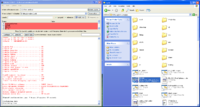Building from SVN
- BRL-CAD Recently moved from SVN to Github. Building from SVN works as of 3 Jul 2021, but you may need to build from Github in the future. ***
Contents
Obtain the sources via Subversion
For Windows:
Install a Subversion client for Windows, such as TortoiseSVN: https://sourceforge.net/projects/tortoisesvn/
To get a checkout after installing TortoiseSVN, right-click in a folder where you want to download the sources, select SVN Checkout and specify https://svn.code.sf.net/p/brlcad/code/brlcad/trunk for the repository URL.
For Linux/Mac/BSD:
svn checkout https://svn.code.sf.net/p/brlcad/code/brlcad/trunk brlcad
Note: If you do not yet have an SVN client installed, go to http://subversion.tigris.org for information on obtaining an appropriate SVN client for your platform. Most modern Linux/BSD/UNIX distributions will also have SVN available in their package repositories.
Configure the build system with CMake
BRL-CAD also requires the build tool CMake. Most Linux/BSD/UNIX systems provide a package for CMake. For platforms that do not, CMake is available from http://www.cmake.org
Once installed, create a directory where you will compile BRL-CAD and run CMake.
For Windows, you can use the CMake GUI where you specify build and source directories:
For Linux/Mac/BSD, this looks like:
cd brlcad mkdir build cd build cmake .. (for a default build) cmake .. -DBRLCAD_BUNDLED_LIBS=ON -DCMAKE_BUILD_TYPE=Release (for a release build)
Compile and test your build
On Windows, simply open the "BRLCAD" solution and Compile.
On Linux/Mac/BSD, run this in your build directory:
make
If there are no compilation errors, you can test via:
make test
You can also run a performance test:
make benchmark
Both the test and benchmark should report successfully if everything is working correctly. Report any failures to the BRL-CAD bug tracker.
Doxygen (OPTIONAL)
If you have doxygen installed somewhere CMake can find it, then you can build a browsable HTML documentation of the source code. This is useful if you want to use BRL-CAD's libraries directly, or if you just want a better overview of how things are structured.
To build the HTML files on a Linux/Mac/BSD system, run (from your build directory):
make dox
and then open doc/doxygen_output/html/index.xhtml with your web browser of choice.
Install (OPTIONAL)
On all systems, you can simply run directly from the build directory without installing.
That said, by default BRL-CAD installs into /usr/brlcad or /opt/brlcad on Linux/Mac/BSD and into the standard program directory on Windows. To check your build or install of BRL-CAD, browse to the "bin" directory from the GUI or from cmd.exe and run "mged".
Setup environment (OPTIONAL)
At this point, all that remains is setting your system PATH environment variable so BRL-CAD utilities can be found. Installation does not set PATH for you automatically.
For Windows, setting PATH can be helpful but isn't necessary. Simply navigate to where you installed BRL-CAD and run from there.
For Linux/Mac/BSD, you'll either need to specify full paths to applications (e.g., /usr/brlcad/bin/rt) or set your PATH. If the default installation prefix (/usr/brlcad or /opt/brlcad) was used, you should only need to add /usr/brlcad/bin to your PATH in order to find applications (optionally setting MANPATH as well):
For bash:
export PATH="/usr/brlcad/bin:$PATH" export MANPATH="/usr/brlcad/man:$MANPATH"
For csh/tcsh:
set path=( /usr/brlcad/bin $path ) setenv MANPATH "/usr/brlcd/man:$MANPATH" rehash
To find BRL-CAD manual pages without setting your MANPATH, use the provided "brlman" binary instead of "man" (e.g., /usr/brlcad/bin/brlman rt).
Test your Build
If compilation went well, there should now be more than 400 command-line applications at your disposal for processing images and geometry. You should be able to run the main modeling application:
mged
If you didn't install, you may need to specify the path to the tool (e.g., "bin/mged") from the build directory.
